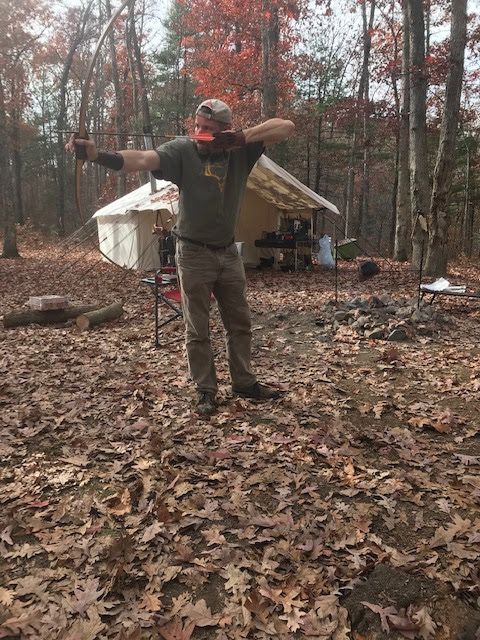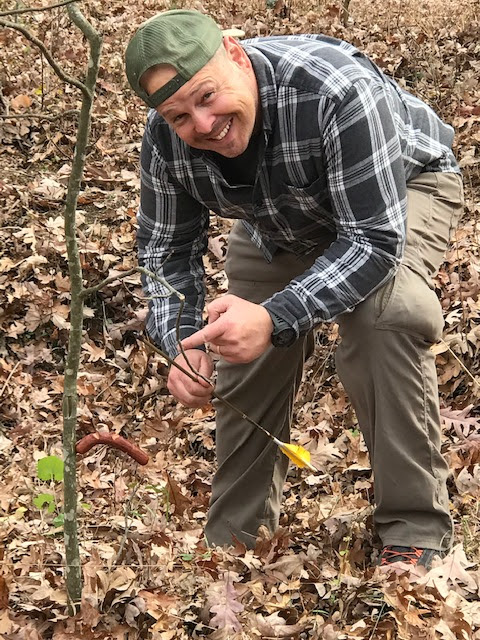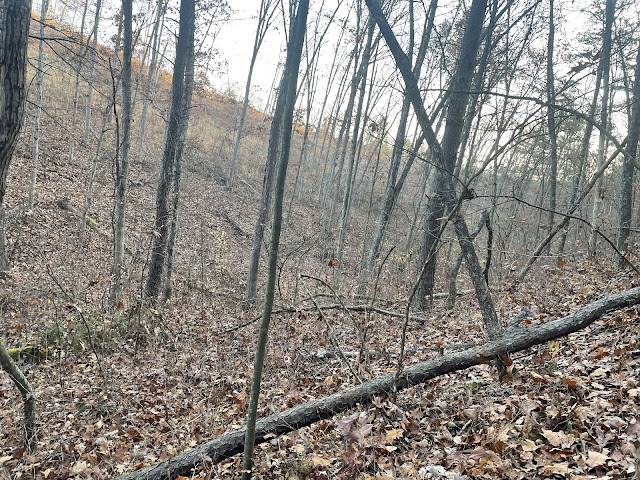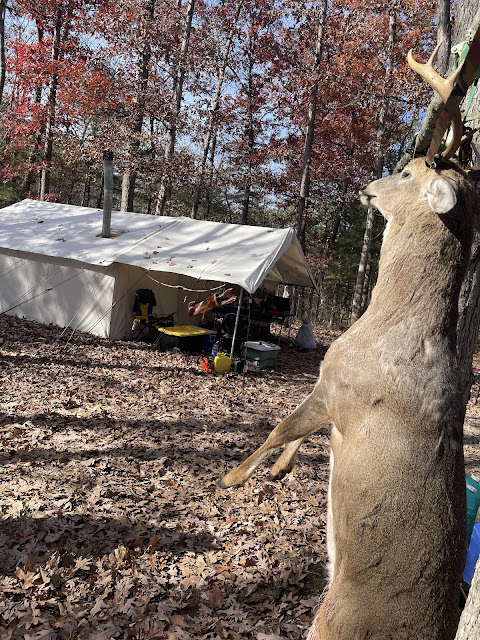* Originally published in Traditional Bowhunter Magazine - "Almost Gone to the Dogs" April May 2024
Every fall I look forward to taking
out my canvas wall tent and wood stove combination to hunt for whitetails on
public land in the western Allegheny mountains of Maryland. Last year I hunted and camped alone after
several local friends had other obligations.
This year, I extended the invitation to others hoping for a larger old
fashioned deer camp experience. When all
was said and done, our camp involved longbow shooters from Alabama, North
Carolina, New Jersey and Maryland. This
was going to be interesting, but I had no idea what excitement lay ahead.
I arrived first and pulled into a large,
secluded pull-through primitive campsite equipped only with a stone fire ring
and a wooden picnic table situated to the side of a quiet winding gravel forest
road. I began to set up as light rain was
beginning to fall but I I would soon have the woodstove roaring. Finishing up the niceties of a simple camp,
my guests began to filter in. I whipped up a quick dinner of noodle soup and
venison strap steaks seared on the cast iron. The crackling wall tent wood stove and pelting
of rain against the fly combined to send travel weary hunters to bed early.
Interior of my palatial wall tent.
The next day’s hunts were relatively
uneventful until on Wednesday morning a partner and I hunted down the road from
camp around a big clear-cut ending at a steep ravine. Splitting up, I still hunted a foggy misty
morning in the direction of camp and after a few hours started to get
fatigued. I was sloppy and cracked a twig
noticing movement from the deep ravine ahead. Up the far hill and approaching
the ridge was the biggest buck I’ve ever seen on this hit hard public
area. I watched him briefly pause to
look back agitatedly before stiffly exiting the area. I made a mental note to try back there later
in the week, knowing I would likely never see him again.
Thursday morning arrived and we all
changed things up and drove 45-minutes away from camp to hunt a nearby wildlife
management area that had differing terrain. Arriving just at twilight, we dropped off two
archers lower on the slope and three of us spread out up high along the ridge. I
anchored the farthest position. Finding
a seat on a deadfall overlooking a downhill trail and an open bench to the
front, I eventually spotted three does about 70 yards away feeding casually. Watching them mill about for about an hour,
they were not getting any closer. I finally
convinced myself to try a stalk or I would never get a shot. The ground was covered in crunchy freshly
fallen leaves covering loose flat slate rocks on a steep hillside. I wasn’t optimistic but gave it a try.
It took me about an hour to get up
to the thickly brushed area they were working into. I never saw more than one
deer at any given time, so I expected to be busted at any moment. They all fed
off into this thicket and I lost sight of all. Creeping up close, I thought they must have
already fed out the other side or ran off without me knowing. Then, I glanced to my right and a doe was feeding
with head down only 20 yards away. There
was an opening in the brush surrounding the vitals. Maybe a 10-inch hole at
most to shoot through, but I felt I could make that shot. I loosed, and
immediately regretted it as the arrow deflected and I heard the thump of the
arrow hitting a log beyond.
All deer burst to the far end of
the thicket and out of sight. Bummed, I got myself together and went to collect
my arrow, sure of a miss. I gawked in
horror as I spotted my arrow barely in the log and covered in stomachy
digestive slime. It was a sure sign of a
terrible gut shot!
Scanning far uphill with my binos, I
see three deer just under the crest of the ridge making their escape. The last
deer had a bright red blood spot near the back leg. I watched as 2 deer finally
trotted over the ridge out of sight. The third never joined. I backed out quietly and returned in the
direction of the truck. We all decided it was best to leave and come back in
the evening. That evening, sneaking up
into the blow-down area where I saw her last, I glanced left and laying dead behind
a root ball was my deer. I was relieved
beyond description. She was still warm
and not stiff so I was glad I didn’t push her.
That night I was euphoric at being
able to pull off that stalk as I worked cutting up the meat and getting it on
ice between congratulations. The deer wasn’t huge but having success with a
camp full of hunters was beyond expectations and a totally new experience for
me. I trimmed up the ribs and skewered
them on the fire-iron to roast above the open coals and share with my friends.
That young doe was good eating. Seared straps,
ribs, and a good snort of bourbon had everyone in camp feeling fine. Having filled my doe tag, I was left to hunt
antlered deer for the rest of the trip.
I figured I would return to the area I saw the big buck days before but
honestly wasn’t very hopeful. Regardless,
if I didn’t see another animal the rest of the week it would still be a
legendary hunt. I was the host on this
one, and I hoped the others could get into some action too. After a long day, I was looking forward to my
cot and stumbled wearily toward the hiss of the Coleman lantern.
Dan, Steve S. and Mike discuss equipment choices.
Steve Turay relaxing at camp enlightens Dan as Steve Spencer looks on.
The next morning, I was up early
and prepared coffee and egg sandwiches for the group as they set off on their
hunts. Leaving camp well after sunup, I
walked down to the drainage where I kicked out the large buck two days before. Setting up a little farther South at a place
where another valley entered, I nestled into the Waldrop packseat leaning up against
a large tree on one side of the steep hill.
The steep opposing hillside was still in bow range, and I was opposite a
deadfall that caused a choke point there.
The wind was a little variable but blowing steady uphill away from the
far slope. It was a particularly chilly morning,
and I was enjoying watching the sun march slowly down the opposing slope and steadily
melt the frost when the silence was shattered.
A deer came crashing over the steep ridge to my front at full speed. I
expected to see a buck chasing a doe, but quickly realized the front animal was
a large antlered buck. The animal that
appeared chasing him at full speed was a coyote!
I watched them both streaking
across the opposing slope, they made a U-turn and mad dash back midway down the
slope still full speed. After they
passed even with me again, another coyote appeared over the crest and joined in
the chase. The buck soon had enough of
the sprinting and stopped turning to face his attackers. He turned the tables and chased one yote
about 50 yards, then rearing around went after the other. I was in shock at witnessing the spectacle of
this amazing wildlife battle unfold before me.
Snapping myself out of my stupor I
thought briefly about pulling my phone and videoing the scene. Then I told myself this may be my one chance
to get close enough for a shot! I made
up my mind to go for it and take a chance. Standing and quietly folding my packseat with attached
back quiver, I slung it over my shoulders and moved at a trot across the ravine.
Climbing steeply into the sunlight, I
slowed when approaching where I had last seen the animals. Glancing at the floss at my limb tip I
realized the wind was blowing slightly uphill from the morning thermals. I was thinking the wind must have given me
away, and I strained to hear and see anything for several long minutes. Finally, I saw a white tail flash above the
brush and my throat tightened. Stalking
toward him at a crouch in the largely open clearcut, I was able to move about
10 yards closer when he turned and faced my direction. I froze at half crouch and watched as he
moved side to side facing his dispersed attackers, unseen due to the high grass
and immature trees. He was now in bow
range and quartering slightly toward as I marveled at a massive animal
highlighted with sun glinting off his rippling angry coat. He took a skip forward and cut loose with a
bellowing snort as I watched bursts of snot spray from each nostril backlit by
the low angled sun. I found myself a bit
uneasy as he was royally pissed!
The buck continued to square off in
different directions putting me frozen at half draw several times. Through all of this I never did see the yotes
and they could not see me. Only the
chest of the buck was visible. One of them tuned the buck around at 25 yards
and broadside. His shoulder shuddered in
anger as I picked out a tuft of fur behind it to focus on. I don’t remember anything of the draw and shot
after that moment. The arrow impacted
somewhere back from my aim point. He
immediately whirled around and started in a frenzied run directly towards me! I noticed his wide rack and his demeanor that
instantly changed from anger to wide eyed PANIC. I stepped back reaching for a follow-on arrow
as he leapt passed me in air at barely three feet. I noticed my arrow dangling with the
appearance of poor penetration low in the back quarter of the animal. As I reached anchor again, he was speeding
away about 30-40 yards. My arrow was
enroute when he changed course slightly downhill and the shaft sailed by
harmlessly several feet uphill. He
passed over a rise and out of sight into the ravine continuing to bowl over dead
fall and branches. Seemingly traveling
far after last sight by the sounds, all fell silent. I was left shaking in the quiet sunshine. My mind struggled with what to do next. It seemed like a gut shot and common advice
would have been to pull out and wait many hours. I could find no easy sign near where he ran
by, there was no obvious trail of exit, and the rocky terrain was not easy to
see prints. If I let him lay with the
yotes already on his scent, they would likely find him quickly if he was
down. He was obviously exhausted and may
have been already injured or weak. I resolved
to gamble and go hard for him. I quickly
pulled back to camp, retrieved my better binoculars, and stripped off a few
layers of clothes. The terrain was
mostly open and good glass would be beneficial.
Most of the other guys were a few hours away, so I left camp on my own
to beat the yotes and hoping for the best.
Dropping back into that ravine, I
quietly started creeping along and glassing the opposing hillside. I gambled he
continued to run downhill to the drainage and hadn’t circled up again. Working along both hillsides alternately
glassing the opposing side, I scrutinized the ground in turn. Taking my time
and being methodical, I peered way ahead though the thick river bottom
brush. I was about 150 yards away from
the shot now and getting worried. Things
were really getting dense as I neared where I had bumped him a few days prior. It was increasingly difficult to be quiet and
I was worried he was pushed well ahead of me and moving away. I was second guessing my decision to wait for
help and surround the area.
Then everything changed as I spotted a small splash of orange jutting out from behind a downed trunk. My eyes followed the fletching down and I realized my buck was there upside down and wedged beneath branches. I was overcome with a wave of gratitude and relief. My goodness, I had done it! I went after the biggest buck I had ever seen here on this public mountain area and ended up with my hands around the buck’s antlers in a way I would have never anticipated.

Starting the skinning back at camp,
we probed a shallow puncture wound in the deer’s chest. It was a few inches wide and several inches
deep with infection, but the rest of the shoulder was fine. The yotes must have smelled the rut induced
injury, knew he was an older buck, and decided to run him down. Skinning down the neck we noticed a traumatic
injury that had healed up long ago. The
throat muscles were missing in about a 4-inch circle and the esophagus was
missing a 1-inch chunk but was now covered in a thin membrane. How he even survived such an injury was
amazing! There was also a large patch of shortened / stunted fur on the back of
the shoulders. To me, it looked like
something had jumped on the shoulders and ripped at the throat at some
point. Later, a local deer biologist
told me the age of the buck was 6.5 years old (by tooth wear) and that injury
was likely caused by a bobcat when he was a fawn.
Remarkable healed over missing patch of throat muscle and 1 inch section of windpipe gone visible upon skinning.
Festering puncture wound from the rut that the dogs probably scented.
This buck was an old warrior, and I probably saved him from a long and painful death at the hands of the dogs. He will now hold a place of honor in my home and memories. A fitting end to a true survivor. Sharing this hunt of a lifetime from an old-fashioned bowhunting camp with a group full of like-minded friends was quite the blessing.
Some of the group that stayed for the final photo:.JPG)


















